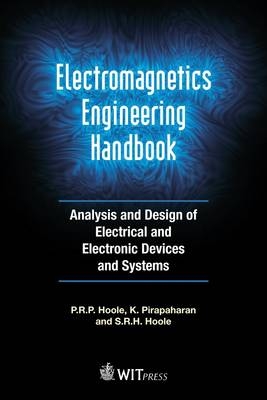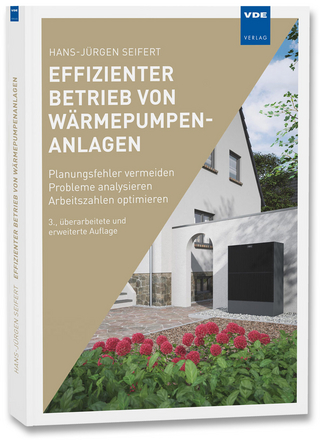
Electromagnetics Engineering Handbook
WIT Press (Verlag)
978-1-84564-798-8 (ISBN)
g. semiconductor materials, magnetic materials, biological tissues, outer space and sea water). It also deals with a range of different functions dependant on the area of application. For example at very low power frequencies electromagnetic fields perform vastly different functions from device to device, such as in power transformers; current transformers; infrared sensors; synchronous generators; superconducting devices; electric motors and electric powered transport systems. This handbook will be of great help to students, engineers, innovators and researchers working in a wide variety of disciplines
Prof. Paul R.P. Hoole was born in Jaffna, Sri Lanka in 1958. After having his basic schooling in Jaffna, he earned all his degrees, first degree to postgraduate, in the United Kingdom. He holds an MSc degree in Electrical Engineering with a Mark of Distinction from the University of London and an MSc degree in Plasma Science from University of Oxford. His doctorate, the DPhil. degree, is from the University of Oxford. In his engineering career he has spent time in Singapore, Papua New Guinea, USA, Sri Lanka and Malaysia. His most recent published research has been in the areas of electromagnetic wireless communication/navigation antennas, electromagnetic brain technology and science, climate electromagnetics and lightning-aircraft electrodynamics. Beyond the time he devotes to engineering teaching and research, Prof. Hoole also spends time studying and teaching the Bible applied to contemporary times in seminaries and churches. He is married to a medical doctor, Chrishanthy, and they have three children: Esther, Ezekiel and Elisabeth. Dr K. Pirapaharan, BSc. Eng. Hons (Peradeniya), M.Eng (Kinki, Japan), PhD (Kinki, Japan), is Senior Lecturer at School of Engineering, Taylor's University in Malaysia. His PhD degree is in the area of microwave and millimeter waves. From 2001 to 2003, he was a postdoctoral research associate at the Centre for Computational Electromagnetics, University of Illinois at Urbana Champaign, USA. From 2004 to 2011, he was a Senior Lecturer in the Electrical and Information. Prof. S. Ratnajeevan H. Hoole, BSc. Eng. Hons Cey., MSc with Mark of Distinction London, PhD. Carnegie Mellon, is Professor of Electrical and Computer Engineering at Michigan State University in the US. For his accomplishments in electromagnetic product synthesis the University of London awarded him its higher doctorate, the DSc. (Eng.) degree, in 1993, and the IEEE elevated him to the grade of Fellow in 1995. Prof. Hoole has been Vice Chancellor of University of Jaffna in Sri Lanka, and as Member of the University Grants Commission there, was responsible with six others for the regulation of the administration of all 15 Sri Lankan universities and their admissions and funding. He has contributed widely to the learned literature on Tamil studies and been a regular columnist in newspapers. Prof. Hoole has been trained in Human Rights Research and Teaching at The Rene Cassin International Institute of Human Rights, Strasbourg, France, and has pioneered teaching human rights in the engineering curriculum. Engineering Department at University of Ruhuna, Sri Lanka where he was the head of the department from 2005 to 2008. Dr Pirapaharan's research interests include wave propagation in inhomogeneous media, adaptive antenna techniques and computational electromagnetics. He is a member of the IEEE and IET.
Contents Vector analysis Vectors and scalars; Orthogonal coordinate system; The Cartesian coordinate system; The cylindrical coordinate system; The spherical coordinate system; Products of vectors; Fields; The gradient of the scalar field; The line integral of a vector field; Divergence of a vector field; The divergence theorem; Curl of a vector field; Stokes' theorem; Vector identities; For further reading Static fields and Maxwell's equations Introduction; Basic electromagnetic theory: Maxwell's equations; Vector potential functions; Boundary conditions; Continuity equation; Electrostatics; Magnetostatics: magnetic fields due to electric currents; Further topics in electrostatics; For further reading Dynamic fields and Maxwell's equations Introduction; Time harmonic signals: why sinusoidal sources?; Electromagnetic induction: magnetic fields due to time-varying electric fields; Electromagnetic waves: general; Electromagnetic waves: plane waves; Energy in the electromagnetic field; Electromagnetic fields and electric circuits; Electromagnetic fields and magnetic circuits; Dielectric material and frequency-dependent; permittivity; Conductors and frequency-dependent conductivity; For further reading 4Electromagnetic waves The wave equation; Uniform plane waves; Conductors and dielectrics; Normal incidence of uniform plane wave; Polarization of uniform plane waves; Oblique incidence of uniform plane waves on plane Boundaries; For further reading Computer-aided design Computer-aided design - in pursuit of accuracy; Methods of approximate solution - differential and integral; A note on matrix representation of polynomials; The finite element method; Uniqueness; Natural boundary conditions; One-dimensional linear finite elements; Two-dimensional linear triangular finite elements; A two-dimensional finite element program through an example; Other equations; For further reading Transmission lines and waveguides TEM waves on transmission line; Transmission line equations; Reflection in transmission lines; The Smith Chart; Applications of transmission lines; Waveguides; Rectangular waveguides; Cavity resonators; For further reading Antennas I: Electromagnetic radiation and interference Antennas for telecommunications and remote sensing; Broadcast frequency bands; Basic characteristics and definitions of terms; Antenna input impedance; Effective aperture; Antenna temperature; Antenna operating zones; Antenna operating principles; Antenna radiation (or beam) patterns; Antennas as a temporal filter: frequency bandwidth; Antenna as a spatial filter: angular beamwidth; Reciprocity; Antennas and Maxwell's equations; Antenna analysis; Elemental current antennas; General: finite-length linear dipole antenna and radiated signals; Antenna radiated signal propagation: an introduction; Reflection coefficients for vertically and horizontally polarized electromagnetic signals; Antenna measurements; Ionizing and nonionizing electromagnetic fields: health hazards; Antenna system for measurements and surveillance; For further reading Antennas II: Electromagnetic radiation and noise Introduction; Array antennas; Traveling wave antennas; Aperture antennas; EMI and EMC; For further reading Influence of radical pair reactions on biological rhythms Introduction; Magnetoreception in animals; Biological rhythms; Radical pair mechanism; Results and discussion; Conclusion; For further reading Radio frequency electromagnetic fields from mobile phones Introduction; Biological effects; Experiments in Sweden; Finite-difference time domain for SAR calculation; Discussion; Conclusions; Acknowledgments; For further reading; Appendix A Electric field intensity Nomenclature Physical constants; Conductivity, at room temperature; Relative permittivity, at low frequencies; Relative permeability; Frequency bands: general; Frequency bands: microwaves; Basic mathematical relations; Symbols used in text; List of prefixes (multipliers)
| Erscheint lt. Verlag | 25.7.2013 |
|---|---|
| Zusatzinfo | Illustrations |
| Verlagsort | Southampton |
| Sprache | englisch |
| Maße | 156 x 234 mm |
| Themenwelt | Technik ► Elektrotechnik / Energietechnik |
| ISBN-10 | 1-84564-798-X / 184564798X |
| ISBN-13 | 978-1-84564-798-8 / 9781845647988 |
| Zustand | Neuware |
| Informationen gemäß Produktsicherheitsverordnung (GPSR) | |
| Haben Sie eine Frage zum Produkt? |
aus dem Bereich


